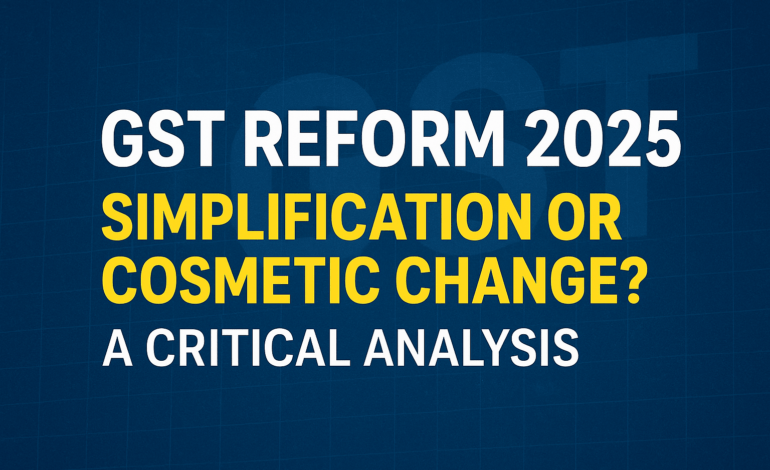
GST reform 2025: simplification or cosmetic change? A critical analysis
By Dr. Avi Verma
India’s Goods and Services Tax (GST) was once hailed as the most ambitious tax reform since Independence, promising “one nation, one tax” and a seamless marketplace. Eight years later, its journey has been far from smooth. Frequent amendments, confusing slab structures, and compliance bottlenecks have often left both businesses and consumers frustrated. Now, with the new GST framework effective September 22, 2025, the government has attempted a bold reset — reducing the system to three main slabs (5%, 18%, and 40%), slashing taxes on essentials, and exempting healthcare-related premiums.
On paper, this reform appears beneficial. Daily essentials like milk, hygiene products, and packaged food will now be cheaper, easing the burden on households already grappling with inflation. Life-saving medicines, medical devices, and life and health insurance premiums being moved to the exempt category is a particularly progressive step, ensuring healthcare is treated not as a privilege but as a necessity. Reduced GST on compact cars and home electronics such as ACs and televisions could boost consumption, supporting demand in the broader economy. The inclusion of eco-friendly products like rice husk boards and gypsum-based substitutes in the lower slab also aligns with India’s sustainability goals, while providing relief to MSMEs engaged in such manufacturing.
Critical Perspective
However, challenges remain. Even with a three-slab structure, classification disputes may continue. For example, will a premium packaged biscuit fall under the 5% essential category or the 18% general slab? Such ambiguities have historically caused litigation and compliance headaches. The steep 40% slab for luxury and sin goods, while politically appealing, risks distorting markets. India’s luxury automobile sector, for instance, employs thousands and attracts foreign investment. A punitive 40% rate could reduce consumption, impact growth, and in the long run, harm revenue rather than increase it.
States have also often complained of delayed compensation and reduced fiscal autonomy under GST. Streamlining rates further increases dependence on the GST Council, potentially intensifying political disputes. Without better revenue-sharing mechanisms, this reform risks centralization rather than genuine tax simplification.
On the compliance front, small businesses still face challenges with filing, digital infrastructure, and input tax credit reconciliation. For them, the problem was never just the number of slabs — it was the complexity of the system. Unless the government strengthens GSTN (the IT backbone), reduces portal downtime, and simplifies return filing, “ease of doing business” will remain aspirational.
Economists also warn about the revenue implications. Lowering taxes on essentials and exempting healthcare reduce the tax base. Relying on luxury goods taxed at 40% to compensate could introduce volatility, as luxury demand is sensitive to economic cycles. A more stable approach would involve widening compliance, cracking down on evasion, and integrating more services into GST.
Global Comparison
Globally, India’s GST remains a multi-tiered system, unlike several other countries that have simpler frameworks:
- Singapore: Singapore has a single GST rate of 8% (set to rise to 9% in 2026). A single rate simplifies administration and compliance, avoids disputes, and ensures clarity for both businesses and consumers.
- Australia: Australia’s GST is a single 10% rate applied to almost all goods and services, with exemptions only for basic necessities like fresh food and certain health services. The system is straightforward and predictable.
- European Union: Most EU countries operate a two-tier VAT system — a standard rate (usually 20-25%) and a reduced rate for essentials such as food, healthcare products, and public transport. This reduces complexity while protecting low-income households.
- Canada: Canada has a combination of federal and provincial VAT (Goods and Services Tax and Provincial Sales Tax), but most provinces apply a single rate or a simple harmonized rate, with some exemptions for essentials.
Compared to these nations, India’s three-slab system is simpler than the previous five- or six-slab model, but still more complex than single-rate systems, making compliance and administration more cumbersome.
Conclusion
While the reform is progressive — reducing the burden on households, promoting healthcare affordability, supporting MSMEs, and encouraging sustainability — it is not without limitations. Execution will determine its success: clarity in classification, ease of compliance, fair revenue-sharing, and a robust IT infrastructure are essential.
The IndoUS Tribune acknowledges the positives but cautions that without addressing systemic flaws, GST risks remaining a halfway reform. A truly simplified, fair, and growth-friendly tax system is possible — but only if the government learns from global examples, aligns policy with administration, and balances revenue needs with equity.
India now stands at a crossroads: this GST reset could be a stepping stone to a world-class taxation framework or another incremental change celebrated in headlines while businesses and citizens continue navigating complexity. Only time and consistent execution will tell.